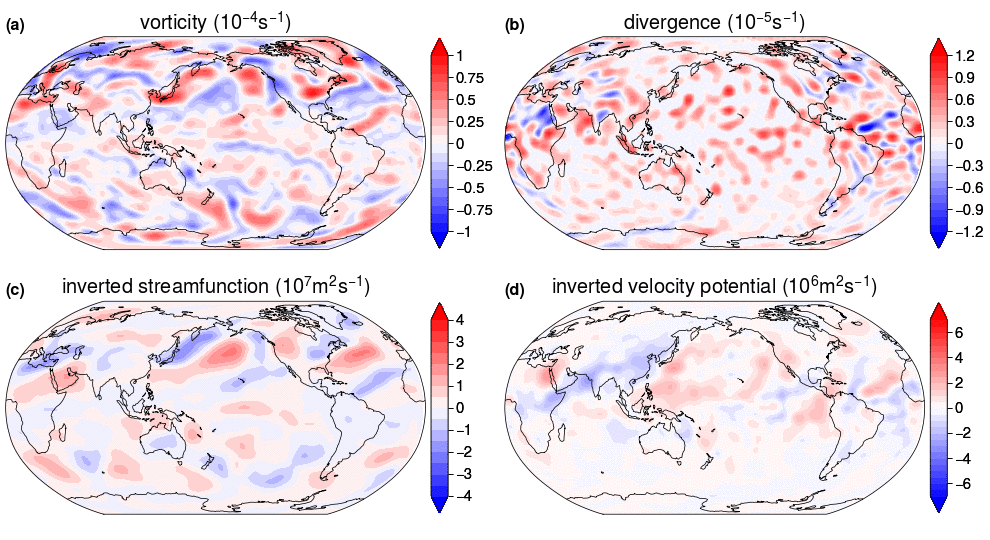Researches on meteorology and oceanography usually encounter inversion problems that need to be solved numerically. One of the classical inversion problem is to solve Poisson equation for a streamfunction
$$\nabla^2\psi=\zeta$$
Nowadays xarray becomes a popular data structure commonly used in Big Data Geoscience. Since the whole 4D data, as well as the coordinate information, are all combined into xarray, solving the inversion problem become quite straightforward and the only input would be just one xarray.DataArray of vorticity. Inversion on the spherical earth, like some meteorological problems, could utilize the spherical harmonics like windspharm, which would be more efficient using FFT than SOR used here. However, in the case of ocean, SOR method is definitely a better choice in the presence of irregular land/sea mask.
More importantly, this could be generalized into a numerical solver for elliptical equation using SOR method, with spatially-varying coefficients. Various popular inversion problems in geofluid dynamics will be illustrated as examples.
One problem with SOR is that the speed of iteration using explicit loops in Python will be e-x-t-r-e-m-e-l-y ... s-l-o-w! A very suitable solution here is to use numba. We may try our best to speed things up using more hardwares (possibly GPU).
Classical problems include Gill-Matsuno model, Stommel-Munk model, QG omega model, PV inversion model, Swayer-Eliassen balance model... A complete list of the classical inversion problems can be found at this notebook.
Why xinvert?
-
Thinking and coding in equations: User APIs are very close to the equations: unknowns are on the LHS of
=, whereas the known forcings are on its RHS; - Genearlize all the steady-state problems: All the known steady-state problems in geophysical fluid dynamics can be easily adapted to fit the solvers;
-
Very short parameter list: Passing a single
xarrayforcing is enough for the inversion. Coordinates information is already encapsulated. -
Flexible model parameters: Model paramters can be either a constant, or varying with a specific dimension (like Coriolis
$f$ ), or fully varying with space and time, due to the use ofxarray's broadcasting capability; -
Parallel inverting: The use of
xarray, and thusdaskallow parallel inverting, which is almost transparent to the user; -
Pure Python code for C-code speed: The use of
numbaallow pure python code in this package but native speed;
Requirements
xinvert is developed under the environment with xarray (=version 0.15.0), dask (=version 2.11.0), numpy (=version 1.15.4), and numba (=version 0.51.2). Older versions of these packages are not well tested.
Install via pip
pip install xinvertInstall from github
git clone https://github.com/miniufo/xinvert.git
cd xinvert
python setup.py installThis is a list of the problems that can be solved by xinvert:
One can see the whole convergence process of SOR iteration as:
from xinvert import animate_iteration
# output has 1 more dimension (iter) than input, which could be animated over.
# Here 40 frames and loop 1 per frame (final state is after 40 iterations) is used.
psi = animate_iteration(invert_Poisson, vor, iParams=iParams,
loop_per_frame=1, max_frames=40)See the animation at the top.
If you use the package in research, teaching, or other activities, we would be grateful
if you mention xinvert and cite our paper in JOSS:
@article{Qian2023,
doi = {10.21105/joss.05510},
url = {https://doi.org/10.21105/joss.05510},
year = {2023},
publisher = {The Open Journal},
volume = {8},
number = {89},
pages = {5510},
author = {Yu-Kun Qian},
title = {xinvert: A Python package for inversion problems in geophysical fluid dynamics}, journal = {Journal of Open Source Software}
}











